|
||||||
|
LAMIUM. Dead-nettles. [Lamiaceae] |
|
|
Nine species of Lamium are recorded in Britain. These include the native Henbit Dead-nettle (L. amplexicaule), Northern Dead-nettle (L. confertum), Cut-leaved Dead-nettle (L. hybridum), Red Dead-nettle (L. purpureum) and White Dead-nettle (L. album). Fourteen British miners are recorded on Lamium. A key to the European miners recorded on Lamium is provided in Bladmineerders van Europa. |
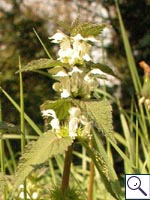 White Dead-nettle Lamium album |
|
|
|
Key for the identification of the known mines of British |
|||
| Note: Diptera larvae may live in a corridor mine, a corridor-blotch mine, or a blotch mine, but never in a case, a rolled or folded leaf, a tentiform mine or sandwiched between two more or less circular leaf sections in later instars. Pupation never in a cocoon. All mining Diptera larvae are leg-less maggots without a head capsule (see examples). They never have thoracic or abdominal legs. They do not have chewing mouthparts, although they do have a characteristic cephalo-pharyngeal skeleton (see examples), usually visible internally through the body wall. The larvae lie on their sides within the mine and use their pick-like mouthparts to feed on plant tissue. In some corridor miners frass may lie in two rows on alternate sides of the mine. In order to vacate the mine the fully grown larva cuts an exit slit, which is usually semi-circular (see Liriomyza huidobrensis video). The pupa is formed within the hardened last larval skin or puparium and as a result sheaths enclosing head appendages, wings and legs are not visible externally (see examples).
|
|||
1a > Stem miner: A shallow, inconspicuous external stem mine. Pupation in stem near a node (Spencer, 1972b: 29). |
|||
|
|||
Ophiomyia labiatarum Hering, 1937 [Diptera: Agromyzidae]. |
|||
1b > Leaf miner |
|||
2a > Leaf-miner: A distinctive mine primarily above mid-rib, with irregular short lateral offshoots into leaf blade. Pupation external (Spencer, 1972: 51 (fig. 172), 55; Spencer, 1976: 270, 271 (fig. 486)). Branched, whitish, upper-surface corridor; main axis overlying the midrib; side branches overlying the main lateral veins. (In Campanula and Phyteuma the mine is much less branched, sometimes nothing more than a corridor on top of the midrib). Frass in rather long strings. Usually the mines begins as a long and narrow, shallow, tortuous lower-surface corridor that ends upon the midrib but otherwise is not associated with the leaf venation. Often this initial corridor is filled with callus, and then even less conspicuous. Pupation outside the mine. A linear mine on the upper surface, usually following the midrib and showing side branches along the veins. The frass is in strings. |
|||
|
|||
|
|||
Liriomyza strigata (Meigen, 1830) [Diptera: Agromyzidae]. |
|||
2b > Leaf-miner: Mine not primarily associated with the mid rib. |
|||
3a > Leaf-miner: A blotch-mine invariably adjoining margin of leaf (Spencer, 1976: 110, fig. 105). Upper-surface, yet rather deep, therefore quite transparent, blotch, always along the leaf margin, generally in the distal half of the leaf. The blotch is preceded by a short and broad corridor, most of the time overrun later. Four to eight larvae may co-occur in a leaf. Pupation outside the mine, exit slit in lower epidermis. Puparium reddish brown or reddish-orange |
|||
|
|||
Agromyza flavipennis Hendel, 1920 [Diptera: Agromyzidae]. |
|||
3b > Leaf-miner: A linear-blotch mine, first instar mine is linear, later developing into a conspicuous white blotch. Frass greenish diffused (Spencer, 1972b: 46, 47 (fig. 138); Spencer, 1976: 166). The mine begins with a long, upper-surface, slender corridor. After a moult the larva changes its behaviour, and makes a large, upper-surface primary blotch without apparent feeding lines. Often the blotch overruns more or less the initial corridor. Frass in the corridor liquified to form a wide green band, with a few tiny black granules along the sides. Pupation outside the mine. A narrow gallery leading to a largish blotch on the upper surface. Frass is green and indistinct in the gallery - small grains may be seen at the gallery edge. |
|||
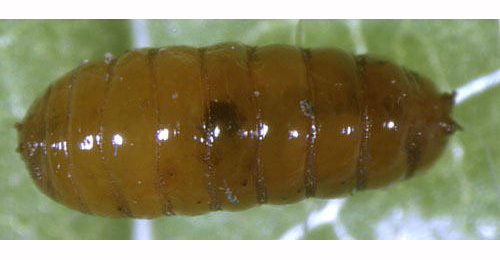 Amauromyza labiatarum puparium Image: © Willem Ellis (Bladmineerders van Europa) |
|||
|
|||
Amauromyza labiatarum (Hendel, 1920) [Diptera: Agromyzidae]. |
|||
3c > Leaf-miner: Initially a long, slim corridor, the frass alternating on either the side of the corridor. After moulting, the larva broadens the mine and the frass is less regular. Pupation external. |
|||
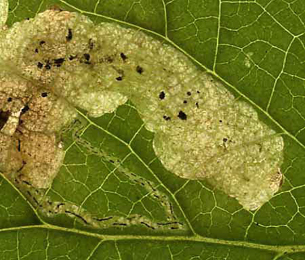 Mine of Amauromyza lamii on Stachys sylvatica Image: © Willem Ellis (Bladmineerders van Europa) |
|||
|
|||
Amauromyza lamii (Kaltenbach, 1858) [Diptera: Agromyzidae]. |
|||
3d > Leaf-miner: An initially linear mine, which at second instar develops into a large whitish blotch with conspicuous black frass. The early linear mine is frequently entirely enveloped by the blotch but is detectable by the alternate irregular strips of frass. Pupation external (Spencer, 1976: 158). The first part of the mine consists of a long, slender upper-surface corridor. After the first moult this changes into a large primary blotch without feeding lines. Frass in the corridor in short, somewhat angular thread fragments, towards the end even in grains. Frass arranged less closely along the sides than in A. lamii. Pupation outside the mine. The frass is conspicuous in the mine and the mine is initially linear, then develops into a white blotch, often enveloping this early mine. |
|||
|
|||
Amauromyza morionella (Zetterstedt, 1848) [Diptera: Agromyzidae]. |
|||
3e > Leaf-miner: Irregular mine, locally shallow, elsewhere much deeper, giving it a mottled appearance. In broadleaved plants the mine often begins as a blotch with stellate extensions, but sometimes as a very fine, shallow corridor. In grasses the mine often begins in the leaf sheath. The frass is very fine-grained, initially scattered, later in aggregates. The egg is deposited on the plant surface, and the empty egg shell remains visible. But the larvae are able to leave their mine and restart elsewhere, thus mines without an egg shell can be found as well. The larva also leaves the mine before pupation. Pupation takes place in a newly made, small, blotch mine without frass; this mine may be made in another plant (species). |
|||
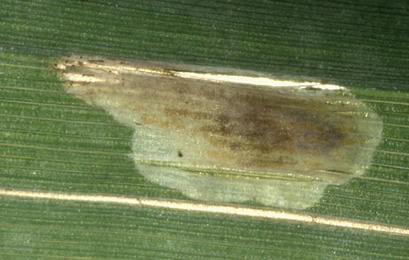 Mine of Hydrellia griseola on Glyceria fluitans Image: © Willem Ellis (Bladmineerders van Europa) |
|||
|
|||
Hydrellia griseola (Fallén, 1813) [Diptera: Ephydridae]. |
|||
3f > Leaf-miner: A short, irregular, linear upper surface mine on any part of the leaf. Also recorded from young pods (Bland, 1997a). Long corridor mine. As a rule the first part of the mine is lower-surface, the later part upper-surface. Often the loops are so dense that a secondary blotch is the result. Because upper- and lower-surface corridor segments often cross, the mine obtains a strange array of transparant patches. There is no association with the midrib. Frass in strings and thread fragments. Pupation outside the mine; exit slit in upper epidermis. Mine not associated with the veins or midrib of the leaf (It is this character which enables distinction from another Agromyzid pest species - Liriomyza huidobriensis). The larvae may leave one leaf (if not large enough) and enter another leaf, via the petiole). It exits the leaf to pupate through a semi-circular slit in the upper surface of the leaf. |
|||
|
|||
Liriomyza bryoniae (Kaltenbach, 1858) [Diptera: Agromyzidae]. |
|||
3g > Leaf-miner: Full depth, initially a much branched corridor, irregular in width, in the end almost a blotch. The mine has openings by which part of the frass is ejected. The larvae frequently leave the mine to restart elsewhere. Older larva live free and cause window feeding, often erasing their old mines. In Coltsfoot also pseudo-mines are made, when the larva eats away the lower epidermis with the leaf tissue, but spares the dense hair cover. |
|||
|
|||
Phytosciara halterata Lengersdorf, 1926 [Diptera: Sciaridae]. |
|||
|
Key for the identification of the known mines of British |
Note: The larvae of mining Coleoptera, Hymenoptera and Lepidoptera may live in a corridor mine, a corridor-blotch mine, a blotch mine, a case, a rolled or folded leaf, a tentiform mine or sandwiched between two more or less circular leaf sections in later instars. Larva may pupate in a silk cocoon. The larva may have six legs (although they may be reduced or absent), a head capsule and chewing mouthparts with opposable mandibles (see video of a gracillarid larva feeding). Larvae of Hymenoptera and Lepidoptera usually also have abdominal legs (see examples). Frass, if present, never in two rows. Unless feeding externally from within a case the larva usually vacates the mine by chewing an exit hole. Pupa with visible head appendages, wings and legs which lie in sheaths (see examples). |
1a > Leaf-miner and case-bearer: The larva lives outside the mine, protected by a case, and feeds on the underlying plant tissues via a hole cut in the epidermis. From that point it eats away as much leaf tissue as it can reach without fully entering the mine. Mine does not contain frass (Coleophora species) |
1b > Leaf-miner, but not a case-bearer: The larva lives mainly inside the mine. Mine usually contains frass. In later instars the larva may live sandwiched between two more or less circular sections cut from the leaf. |
2 > Leaf-miner and case-bearer: The mines are large and obvious on the upper side of the leaf, betraying the larva or larvae on the lower side. Cases are broad and flat - being very hairy from the texture of the leaf. Immediately after emergence the larva makes a full depth, quickly widening, corridor, with frass as small grains in a broad central band. Finally results in a blotch of 2 x 5 mm, from which the young case is cut. The fully developed case is a hairy, greyish brown to silver grey lobe case case of about 1 cm long, with a clearly laterally compressed end; the mouth angle is about 90°. The case is difficult to separate from that of C. ochripennella. |
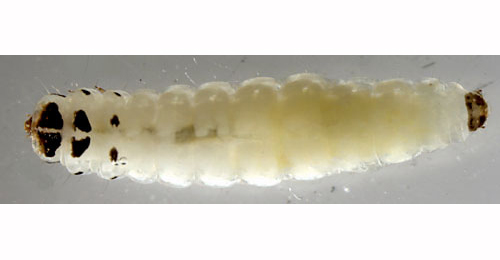 Coleophora lineolea larva, dorsal Image: © Willem Ellis (Bladmineerders van Europa) |
|
Coleophora lineolea (Haworth, 1828) [Lepidoptera: Coleophoridae]. |
3a > Leaf-miner: Rather long corridor winding through the leaf, regularly crossing itself. The corridor later widens considerably. Frass normally in a narrow central line, but may also lie along the side, or be absent. The larva regularly leaves a mine and restarts elsewhere. |
|
Apteropeda globosa (Illiger, 1794) [Coleoptera: Chrysomelidae]. |
3b > Leaf-miner: Rather long full depth corridor that winds freely through the leaf and may cross itself. In the end the corridor widens considerably. Frass mostly in a narrow central line, but may also be deposited along the sides or be missing. The larvae regular leave a mine to restart elsewhere. Pupation outside the mine. Neither larva or mine can be distinguished from that of related species. |
|
Apteropeda orbiculata (Marsham, 1802) [Coleoptera: Chrysomelidae]. |
3c > Leaf-miner: In the first instar the larva mines the leaves, forming short, irregular, blotch-like mines, but in later instars it lives externally, feeding in spun leaves and often twisting those of tender shoots. Larval head light-brown or yellowish brown, edged with black postero-laterally, ocellar area blackish; prothoracic plate black edged with whitish anteriorly; abdomen dull dark green; pinacula distinct, black, sometimes brownish but with black bases to setae; anal plate large, black (Bradley et al., 1973). Small, full depth mine without a definite shape; little frass. Some silk is deposited in the mine. The larva soon leaves the mine and continues feeding among spun leaves. |
|
Cnephasia incertana (Treitschke, 1835) [Lepidoptera: Tortricidae]. |
3d > Leaf-miner: Rather narrow corridor, untidy and sometimes branched, starting from the base of the leaf, in particular the midrib. Sides of the corridor irregularly eaten out, not really parallel. Frass mostly present, and then in a central line. The larva is capable of leaving the mine and start a new one elsewhere. These later mines are much broader, and the frass is scattered irregularly.. |
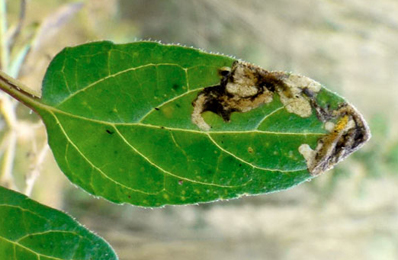 Mine of Orthochaetes insignis on Prunella vulgaris Image: © Jean-Yves Baugnée (Bladmineerders van Europa) |
|
Orthochaetes insignis (Aube, 1863) [Coleoptera: Curculionidae]. |
| Last updated 09-Jul-2020 Brian Pitkin | ||

